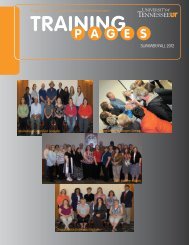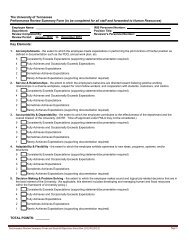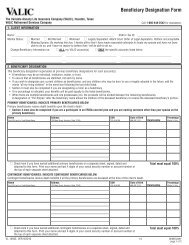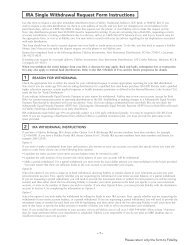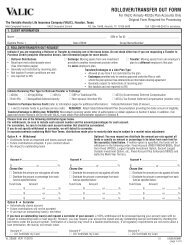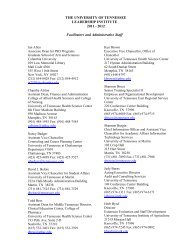bruce w. tuckman - forming, storming norming and performing in ...
bruce w. tuckman - forming, storming norming and performing in ...
bruce w. tuckman - forming, storming norming and performing in ...
You also want an ePaper? Increase the reach of your titles
YUMPU automatically turns print PDFs into web optimized ePapers that Google loves.
uce w. <strong>tuckman</strong> - <strong>form<strong>in</strong>g</strong>, <strong>storm<strong>in</strong>g</strong><br />
<strong>norm<strong>in</strong>g</strong> <strong>and</strong> per<strong>form<strong>in</strong>g</strong> <strong>in</strong> groups<br />
Bruce W. Tuckman produced one of the most quoted models of group development <strong>in</strong> the<br />
1960s. We consider his contribution <strong>and</strong> the model's cont<strong>in</strong>u<strong>in</strong>g use.<br />
contents: <strong>in</strong>troduction · <strong>storm<strong>in</strong>g</strong>, <strong>form<strong>in</strong>g</strong>, <strong>norm<strong>in</strong>g</strong> <strong>and</strong> per<strong>form<strong>in</strong>g</strong> - developmental sequence <strong>in</strong> groups · a fifth<br />
stage - adjourn<strong>in</strong>g · assessment · conclusion · further read<strong>in</strong>g <strong>and</strong> bibliography · l<strong>in</strong>ks · how to cite this article<br />
Bruce Wayne Tuckman (1938- ) is probably best known for a short article - 'Developmental<br />
sequence <strong>in</strong> small groups' first published <strong>in</strong> 1965. However, the vast bulk of his published work<br />
has been concerned more broadly with educational research <strong>and</strong> educational psychology.<br />
Tuckman's book Conduct<strong>in</strong>g Educational Research (first published <strong>in</strong> 1972) has gone through five<br />
editions <strong>and</strong> his Theories <strong>and</strong> Applications of Educational Psychology (first published <strong>in</strong> 1996) is<br />
now <strong>in</strong> it's third edition. Currently Bruce W. Tuckman directs the Academic Learn<strong>in</strong>g Lab at Ohio<br />
State University (from 1998). Previously he had been a Professor of Educational Psychology at<br />
Florida State University (1983-98). From 1965 to 1978 he held a variety of posts at Rutgers<br />
University before mov<strong>in</strong>g to the City University of New York. Currently Bruce W. Tuckman's<br />
scholarly <strong>in</strong>terest focuses on motivation: 'its manifestation <strong>in</strong> the form of self-regulatory behavior,<br />
<strong>and</strong> its absence <strong>in</strong> the form of procrast<strong>in</strong>ation, particularly as applied to the behavior of study<strong>in</strong>g'<br />
(Tuckman 2003) . He is concerned with explor<strong>in</strong>g the l<strong>in</strong>ks between motivational factors <strong>and</strong><br />
school achievement; <strong>and</strong> <strong>in</strong>terventions that enhance the self-regulatory behaviour of students (such<br />
as goal sett<strong>in</strong>g, plann<strong>in</strong>g, <strong>and</strong> <strong>in</strong>centives). Bruce W. Tuckman ga<strong>in</strong>ed his Bachelor of Science from
Renesselaer Polytechnic Institute <strong>in</strong> 1960, his Masters <strong>in</strong> Psychology from Pr<strong>in</strong>ceton <strong>in</strong> 1962 <strong>and</strong><br />
his PhD <strong>in</strong> 1963. He has also written a novel The Long Road to Boston (1988).<br />
Form<strong>in</strong>g, <strong>storm<strong>in</strong>g</strong>, <strong>norm<strong>in</strong>g</strong> <strong>and</strong> per<strong>form<strong>in</strong>g</strong> - developmental sequence <strong>in</strong> groups<br />
Even a quick glance at the literature of group development reveals a wide range of theoretical<br />
models concern<strong>in</strong>g developmental processes. Most commentators assume that groups go through a<br />
number of phases or stages if they exist for an extended period. It is clear, for example, that people<br />
tend to want to know someth<strong>in</strong>g about the other members; have to develop a degree of<br />
<strong>in</strong>terdependence <strong>in</strong> order that the group or team may achieve its tasks <strong>and</strong> be satisfy<strong>in</strong>g to its<br />
members; <strong>and</strong> has to learn at some level to deal with conflict if it is to survive. The most<br />
<strong>in</strong>fluential model of the developmental process - certa<strong>in</strong>ly <strong>in</strong> terms of its impact upon texts aimed<br />
at practitioners - has been that of Bruce W. Tuckman (1965). While there are various differences<br />
concern<strong>in</strong>g the number of stages <strong>and</strong> their names - many have adopted a version of Tuckman's<br />
model - <strong>form<strong>in</strong>g</strong>, <strong>storm<strong>in</strong>g</strong>, <strong>norm<strong>in</strong>g</strong> <strong>and</strong> per<strong>form<strong>in</strong>g</strong>. He was later to add a fifth stage - adjourn<strong>in</strong>g<br />
(Tuckman <strong>and</strong> Jensen 1977). To beg<strong>in</strong> we will look at his orig<strong>in</strong>al formulation.<br />
The <strong>in</strong>itial four-stage model evolved out of Bruce W. Tuckman's observations of group behaviour<br />
<strong>in</strong> a variety of sett<strong>in</strong>gs <strong>and</strong> his encounter with the literature. After complet<strong>in</strong>g his doctorate<br />
Tuckman had worked with the <strong>in</strong>dustrial psychology lab at Pr<strong>in</strong>ceton <strong>and</strong> then went on to<br />
undertake research on small-group <strong>and</strong> organizational behaviour as a Research Psychologist (GS-<br />
12) at the Naval Medical Research Institute, Bethesda MD. (1963-65). At this po<strong>in</strong>t he argued that<br />
groups were likely to go through four dist<strong>in</strong>ct stages as they come to together <strong>and</strong> beg<strong>in</strong> to<br />
function. These phases or stages might well be recognized <strong>in</strong> some way by participants - but there<br />
mat only be a limited consciousness of the changes <strong>and</strong> their implications. The obvious<br />
implication was that it people could develop a better appreciation of the processes surround<strong>in</strong>g<br />
group development then it would be possible to enhance group effectiveness <strong>and</strong> function<strong>in</strong>g.<br />
Bruce W. Tuckman describes the process as follows:<br />
My first professional job was as part of a small group of social psychologists <strong>in</strong> a th<strong>in</strong>k tank<br />
sett<strong>in</strong>g study<strong>in</strong>g small group behavior as the US Navy prepared for a future of small crew vessels<br />
<strong>and</strong> stations. N<strong>in</strong>e of us at the Naval Medical Research Institute were busy study<strong>in</strong>g small groups<br />
from all perspectives <strong>and</strong> under all conditions. I was fortunate to have an experienced <strong>and</strong> talented<br />
boss by the name of Irw<strong>in</strong> Altman, who had been collect<strong>in</strong>g every article he could f<strong>in</strong>d on group<br />
development. He turned his collection over to me <strong>and</strong> suggested that I look it over <strong>and</strong> see if I<br />
could make anyth<strong>in</strong>g out of it.<br />
The collection conta<strong>in</strong>ed 50 articles, many of which were psychoanalytic studies of therapy or T-<br />
groups. The task of organiz<strong>in</strong>g <strong>and</strong> <strong>in</strong>tegrat<strong>in</strong>g them was challeng<strong>in</strong>g. After separat<strong>in</strong>g out two<br />
realms of group function<strong>in</strong>g, namely, the <strong>in</strong>terpersonal or group structure realm <strong>and</strong> the task<br />
activity realm, I began to look for a developmental sequence that would fit the f<strong>in</strong>d<strong>in</strong>gs of a<br />
majority of the studies. I hit on four stages go<strong>in</strong>g from (1) orientation/test<strong>in</strong>g/dependence, to (2)<br />
conflict, to (3) group cohesion, to (4) functional role-relatedness. For these I co<strong>in</strong>ed the terms:<br />
‘<strong>form<strong>in</strong>g</strong>,’ ‘<strong>storm<strong>in</strong>g</strong>,’ ‘<strong>norm<strong>in</strong>g</strong>,’ <strong>and</strong> ‘per<strong>form<strong>in</strong>g</strong>’ (Tuckman 1984)<br />
This is how Tuckman described the stages <strong>in</strong> the orig<strong>in</strong>al article:<br />
Groups <strong>in</strong>itially concern themselves with orientation accomplished primarily through test<strong>in</strong>g. Such<br />
test<strong>in</strong>g serves to identify the boundaries of both <strong>in</strong>terpersonal <strong>and</strong> task behaviors. Co<strong>in</strong>cident with<br />
test<strong>in</strong>g <strong>in</strong> the <strong>in</strong>terpersonal realm is the establishment of dependency relationships with leaders,<br />
other group members, or pre-exist<strong>in</strong>g st<strong>and</strong>ards. It may be said that orientation, test<strong>in</strong>g <strong>and</strong><br />
dependence constitute the group process of <strong>form<strong>in</strong>g</strong>.
The second po<strong>in</strong>t <strong>in</strong> the sequence is characterized by conflict <strong>and</strong> polarization around <strong>in</strong>terpersonal<br />
issues, with concomitant emotional respond<strong>in</strong>g <strong>in</strong> the task sphere. These behaviors serve as<br />
resistance to group <strong>in</strong>fluence <strong>and</strong> task requirements <strong>and</strong> may be labeled as <strong>storm<strong>in</strong>g</strong>.<br />
Resistance is overcome <strong>in</strong> the third stage <strong>in</strong> which <strong>in</strong>-group feel<strong>in</strong>g <strong>and</strong> cohesiveness develop, new<br />
st<strong>and</strong>ards evolve, <strong>and</strong> new roles are adopted. In the task realm, <strong>in</strong>timate, personal op<strong>in</strong>ions are<br />
expressed. Thus, we have the stage of <strong>norm<strong>in</strong>g</strong>.<br />
F<strong>in</strong>ally, the group atta<strong>in</strong>s the fourth <strong>and</strong> f<strong>in</strong>al stage <strong>in</strong> which <strong>in</strong>terpersonal structure becomes the<br />
tool of task activities. Roles become flexible <strong>and</strong> functional, <strong>and</strong> group energy is channeled <strong>in</strong>to<br />
the task. Structural issues have been resolved, <strong>and</strong> structure can now become supportive of task<br />
performance. This stage can be labeled as per<strong>form<strong>in</strong>g</strong>. (Tuckman 1965 - page 78 <strong>in</strong> the 2001<br />
repr<strong>in</strong>t)<br />
So it was that the <strong>in</strong>fluential model was formulated. As Bruce W. Tuckman has noted these terms<br />
would come to be commonly used to describe develop<strong>in</strong>g groups for the follow<strong>in</strong>g 20 years <strong>and</strong><br />
their character probably accounted for the paper’s popularity.<br />
A fifth stage - adjourn<strong>in</strong>g<br />
In 1977 Bruce W. Tuckman proposed an update of the model (<strong>in</strong> collaboration with Mary Ann<br />
Jensen). He has subsequently commented:<br />
We reviewed 22 studies that had appeared s<strong>in</strong>ce the orig<strong>in</strong>al publication of the model <strong>and</strong> which<br />
we located by means of the Social Sciences Citation Index. These articles, one of which dubbed<br />
the stages the 'Tuckman hypothesis' tended to support the existence of the four stages but also<br />
suggested a fifth stage for which a perfect rhyme could not be found. We called it 'adjourn<strong>in</strong>g'.<br />
(Tuckman 1984)<br />
Adjourn<strong>in</strong>g <strong>in</strong>volves dissolution. It entails the term<strong>in</strong>ation of roles, the completion of tasks <strong>and</strong><br />
reduction of dependency (Forsyth 1990: 77). Some commentators have described this stage as<br />
'mourn<strong>in</strong>g' given the loss that is sometimes felt by former participants. The process can be<br />
stressful - particularly where the dissolution is unplanned (ibid.: 88). In many respects Tuckman<br />
<strong>and</strong> Jensen's addition of 'adjourn<strong>in</strong>g' was less an extension of the model, more an after word. The<br />
orig<strong>in</strong>al article was written from the perspective of the function<strong>in</strong>g group, the fifth 'stage' takes us<br />
beyond that.<br />
Assessment<br />
Several th<strong>in</strong>gs need say<strong>in</strong>g about Bruce W. Tuckman's model. First, it can be subjected to a more<br />
general critique of stage theory (which is discussed elsewhere with regard to life span<br />
development). The sheer scale of such theory - by seek<strong>in</strong>g to present a universal or general picture<br />
can mean it over-reaches itself. While there may be some 'universals of development' when we<br />
come to exam<strong>in</strong>e, <strong>in</strong> this case, the <strong>in</strong>dividual group th<strong>in</strong>gs are rarely that straightforward. Human<br />
processes are frequently characterised by variability <strong>and</strong> flux. Furthermore, our own experiences<br />
of groups are likely to show significant deviations from the path laid out by stage theories. 'Stages'<br />
may be missed out, other ways of nam<strong>in</strong>g a phase or experiences may be more appropriate.<br />
Second, we need to explore the robustness of the actual categories. There is some overlap between<br />
the different stages <strong>in</strong> Bruce W. Tuckman's model - the demarcation is not that clear-cut. For<br />
example, 'when group conflict is wan<strong>in</strong>g... feel<strong>in</strong>gs of cohesion may be <strong>in</strong>creas<strong>in</strong>g, but these timedependent<br />
changes do not occur <strong>in</strong> a discont<strong>in</strong>uous, steplike sequence' (Forsyth 1990: 89).<br />
However, the take-up of the model isn't simply a matter of some catchy titles. Many theorists <strong>and</strong><br />
commentators have used the categories (often re-titled) with only marg<strong>in</strong>al amendment.
Third, Bruce W. Tuckman's model is l<strong>in</strong>ear (sometimes described as 'successive-stage'). A<br />
number of other theorists have proposed cyclical models. An example of how this may occur<br />
comes from Bales (1965). He argued that group members tend to seek a balance between<br />
accomplish<strong>in</strong>g the task <strong>and</strong> build<strong>in</strong>g <strong>in</strong>terpersonal relationships <strong>in</strong> the group. At one po<strong>in</strong>t the<br />
focus will be on the former, at another on the latter. The result is, effectively, a movement between<br />
<strong>norm<strong>in</strong>g</strong> <strong>and</strong> per<strong>form<strong>in</strong>g</strong>. Below we have represented Tuckman's <strong>in</strong>itial model <strong>in</strong> a way that<br />
follows the same phases but allows for issues recurr<strong>in</strong>g at different po<strong>in</strong>ts <strong>in</strong> a group's life.<br />
Fourth, there is a question of the extent to which the attractiveness of the labell<strong>in</strong>g Bruce W.<br />
Tuckman adopted has contributed to unth<strong>in</strong>k<strong>in</strong>g application by tra<strong>in</strong>ers <strong>and</strong> a read<strong>in</strong>g onto groups<br />
of the phases. This really isn't an issue with the formulation - rather how a nice turn of phrase can<br />
lead to laz<strong>in</strong>ess on the part of practitioners <strong>and</strong> tra<strong>in</strong>ers. Bruce W. Tuckman's model offers us a<br />
way of th<strong>in</strong>k<strong>in</strong>g about the groups we encounter <strong>and</strong> participate with<strong>in</strong> <strong>in</strong>. It offers, <strong>in</strong> Donald<br />
Schön's terms a metaphor or image that we can play with to make sense of the phenomenon before<br />
us.<br />
Conclusion<br />
Bruce W. Tuckman's model of the developmental sequence <strong>in</strong> small groups has rightly been<br />
adopted as a helpful start<strong>in</strong>g po<strong>in</strong>t about possible stages or phases with<strong>in</strong> different small groups.<br />
When the orig<strong>in</strong>al article was written it was an important summary of the exist<strong>in</strong>g literature - <strong>and</strong><br />
its longevity reflects Tuckman's ability to categorize <strong>and</strong> synthesize - <strong>and</strong> to get it right. While<br />
there may be all sorts of debates around such approaches to stage theory, <strong>and</strong> around the need for a<br />
model that reflects the flux of groups, there does seem to be some truth <strong>in</strong> the assertion that small<br />
groups tend to follow a fairly predictable path.<br />
Further read<strong>in</strong>g <strong>and</strong> bibliography<br />
Bales, R. F. (1965) 'The equilibrium problem <strong>in</strong> small groups' <strong>in</strong> A. P. Hare, E. F. Borgatta <strong>and</strong> R.<br />
F. Bales (eds.) Small Groups: Studies <strong>in</strong> social <strong>in</strong>teraction, New York: Knopf.<br />
Brown, R. (1999) Group Processes 2e, Oxford: Blackwell.
Forsyth, D. R. (1990, 1998) Group Dynamics, Pacific Grove CA.: Brooks/Cole Publish<strong>in</strong>g.<br />
Schön, D. (1983) The Reflective Practitioner, London: Temple Smith.<br />
Tuckman, Bruce W. (1965) 'Developmental sequence <strong>in</strong> small groups', Psychological Bullet<strong>in</strong>,<br />
63, 384-399. The article was repr<strong>in</strong>ted <strong>in</strong> Group Facilitation: A Research <strong>and</strong> Applications<br />
Journal - Number 3, Spr<strong>in</strong>g 2001 <strong>and</strong> is available as a Word document:<br />
http://dennislearn<strong>in</strong>gcenter.osu.edu/references/GROUP%20DEV%20ARTICLE.doc. Accessed<br />
January 14, 2005.<br />
Tuckman, Bruce W. (1972) Conduct<strong>in</strong>g Educational Research, New York: Harcourt Brace<br />
Jovanovich. Fifth edition 1999 by Wadsworth.<br />
Tuckman, Bruce W. (1979) Evaluat<strong>in</strong>g Instructional Programs, Boston: Allyn & Bacon.<br />
Tuckman, Bruce W. (1984) 'Citation classic - Developmental sequence <strong>in</strong> small groups' Current<br />
Concerns. Available: as a pdf file:<br />
http://www.garfield.library.upenn.edu/classics1984/A1984TD25600001.pdf<br />
Tuckman, Bruce W. (1988; 1998) The Long Road to Boston, Tallahassee, FL: Cedarw<strong>in</strong>ds<br />
Publish<strong>in</strong>g.<br />
Tuckman, Bruce W. (1996) Theories <strong>and</strong> Applications of Educational Psychology, New York:<br />
McGraw Hill. Third edition with D. Moneth published 2001.<br />
Tuckman, Bruce W. (2003) 'Homepage', Ohio State University, http://www.coe.ohiostate.edu/b<strong>tuckman</strong>/,<br />
Accessed January 14, 2005.<br />
Tuckman, Bruce W., & Jensen, Mary Ann C. (1977). 'Stages of small group development<br />
revisited', Group <strong>and</strong> Organizational Studies, 2, 419- 427.<br />
Tuckman, Bruce W. <strong>and</strong> O'Brian, John. L. (1969) Prepar<strong>in</strong>g to Teach the Disadvantaged, New<br />
York: Free Press<br />
L<strong>in</strong>ks<br />
How to cite this article: Smith, M. K. (2005) 'Bruce W. Tuckman - <strong>form<strong>in</strong>g</strong>, <strong>storm<strong>in</strong>g</strong>, <strong>norm<strong>in</strong>g</strong><br />
<strong>and</strong> per<strong>form<strong>in</strong>g</strong> <strong>in</strong> groups, the encyclopaedia of <strong>in</strong>formal education,<br />
www.<strong>in</strong>fed.org/th<strong>in</strong>kers/<strong>tuckman</strong>.htm.<br />
Acknowledgements: The picture, by FredArmitage/flickr is reproduced here under a Creative<br />
Commons Attribution-Non-Commercial-No Derivative Works 2.0 Generic licence.<br />
© Mark K. Smith 2005<br />
<strong>in</strong>fed is a not-for-profit site http://www.<strong>in</strong>fed.org/th<strong>in</strong>kers/<strong>tuckman</strong>.htm



